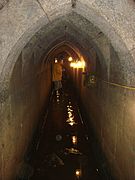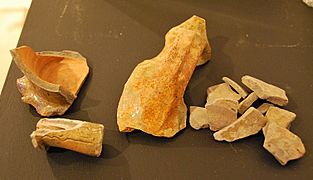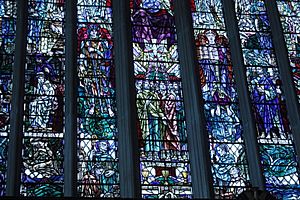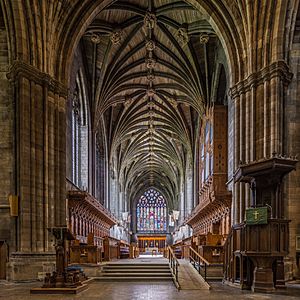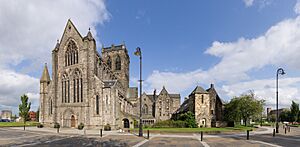Paisley Abbey facts for kids
Quick facts for kids Paisley Abbey |
|
|---|---|

Paisley Abbey and grounds
|
|
| Location | Abbey Close Paisley, Renfrewshire |
| Country | Scotland |
| Denomination | Church of Scotland |
| Previous denomination | Roman Catholic |
| History | |
| Status | Parish kirk |
| Architecture | |
| Functional status | Active |
| Heritage designation | Category A |
| Designated | 1971 |
| Architectural type | Church |
| Years built | 7th century 1163 |
| Administration | |
| Presbytery | Clyde |
Paisley Abbey is a historic church in the town of Paisley, Renfrewshire, Scotland. It stands on the east bank of the White Cart Water, about 7 miles west of Glasgow. The abbey started as a Cluniac monastery in the 12th century. After the Reformation in the 16th century, it became a parish church for the Church of Scotland.
Contents
History of Paisley Abbey
Early Beginnings and Growth
It is believed that Saint Mirin started a religious community here in the 7th century. After he died, a special shrine was built for him. This shrine became a popular place for people to visit and show their respect. The name Paisley might come from an old word, Passeleg, which means 'major church'.
In 1163, Walter fitz Alan, who was the first High Steward of Scotland, gave permission for a priory to be built on his land in Paisley. A priory is a smaller monastery. It was dedicated to several saints, including Mary and Saint Mirin. About 13 monks came from a priory in England to start this new community. Paisley grew very quickly and became an abbey in 1245. An abbey is a larger, more important monastery. Monks from Paisley even helped start another abbey, Crossraguel Abbey, in 1244.
Fires, Rebuilding, and Royal Connections
In 1307, Edward I of England had the abbey burned down. But it was rebuilt later in the 14th century. William Wallace, a famous Scottish hero, is thought to have been educated at the abbey when he was a boy. He was born nearby in Elderslie.
A sad but important event happened near the abbey in 1316. Marjorie Bruce, the daughter of Robert I of Scotland (Robert the Bruce), was riding her horse. She was pregnant and fell off. She was taken to Paisley Abbey for help. There, her son, King Robert II, was born. This was by caesarean section, a very difficult procedure back then without pain medicine. Marjorie Bruce was later buried at the abbey. A stone pile, called a cairn, marks the spot where she supposedly fell.
In 1491, James IV of Scotland and others were forgiven for their part in the death of James III. This happened at the abbey, with the Pope's representative and holy relics present. By 1499, Abbot George Shaw had built a new, larger chapel for pilgrims. He also added a stone frieze that you can still see today. It shows scenes from the life of Saint Mirin. It was once brightly painted.
Over the years, the abbey suffered from more fires and the collapse of its tower in the 15th and 16th centuries. This left parts of the building in ruins. People even took stones from the ruined eastern part. From 1858 to 1928, parts of the abbey, like the north porch and the eastern choir, were rebuilt. Architects Macgregor Chalmers and Sir Robert Lorimer worked on these restorations.
Points of Interest at Paisley Abbey
Paisley Abbey is the resting place for many important people. This includes six High Stewards of Scotland, Marjorie Bruce (mother of Robert II), and the wives of Robert II. Inside the abbey, you can also see the Celtic Barochan Cross. This cross is very old, probably from the 10th century. In the main part of the church, called the nave, there is a window called the Wallace Memorial Window. It shows the image of Samson and was added in 1873.
Paisley Abbey Drain: An Underground Secret
The Paisley Abbey Drain is a fascinating underground tunnel. The first time anyone wrote about it was in 1829. Workers digging in a garden accidentally fell into a tunnel. At the time, people didn't realize how important this discovery was, so the hole was covered up and forgotten. It was mentioned again in a newspaper in 1879, but then forgotten once more.
The tunnel was "re-discovered" in 1990. A 90-meter long section was found running from the abbey to the White Cart River. This drain is thought to be from around 1350-1400. It's quite big, up to 2 meters wide and 2.2 meters high. Inside, you can see marks left by the stonemasons who built it. There are also marks where gates used to be. Before anyone can go into the drain, all the water has to be pumped out.
The Paisley Abbey Drain is a Scheduled Ancient Monument, meaning it's a very important historical site. It's similar to other old monastery drains in Scotland and England. You can even take a virtual tour of the drain online!

Archaeologists have explored and dug at the drain many times since 1996. They have found many interesting items, some of which are now on display in the abbey.
Some of the cool things found include:
- a slate with music on it – believed to be the oldest example of polyphonic music (music with more than one melody at once) found in Scotland.
- imported cloth seals (used to mark fabric).
- chamber pots from around 1500.
- tweezers.
- carved bone handles.
- pieces of pottery.
- pieces of slate.
Events have been held to let the public get involved in learning about the drain's archaeology.
Tombs of Important Figures
In the choir area, there is a tomb with a statue of a woman. Many people believe this is the tomb of Marjorie Bruce. While we don't know for sure if she's buried exactly there, her remains are thought to be somewhere within the abbey. The tomb itself is made from pieces of different origins.
Across from Marjorie Bruce's tomb are the tombs of Robert III of Scotland and Simon fitz Alan. There is also a Latin message remembering three children who died when they were babies: Margaret, Henry, and Alexander.
Beautiful Stained Glass
The abbey once had stained glass windows, but they were removed during the Reformation. Starting in the 1870s, new stained glass began to be added. Some important windows include one by Edward Burne-Jones and the very large east window by Douglas Strachan. There is also a dramatic memorial window from 1989 by John Clark.
The Amazing Abbey Organ
The organ at Paisley Abbey is known as one of the best in Scotland. It was first built in 1874 by a famous French organ builder named Cavaillé-Coll of Paris. This is one of only six such organs in the UK. Since 1874, it has been rebuilt and made bigger four times. The organ, as rebuilt in 1968, has 4 keyboards, 65 stops, and 5448 pipes! In 2009, it had a major restoration. This included cleaning, new air systems, and adding a very deep 32-foot pipe.
Inside the Abbey: Architectural Details
Look closely at the inside of the abbey, and you'll see many cool details. The twelve angel corbels (stone supports) and the stone communion table were made by Pilkington Jackson. He also sculpted the famous Robert the Bruce statue at Bannockburn. The ceiling bosses (decorative carvings where ribs meet) were designed by Sir Robert Lorimer and carved by James A Young. The choir stalls, which are the seats for the choir, have many carved animals and were made by William and Alexander Clow.
Outside the Abbey: Fun Gargoyles
Paisley Abbey has been rebuilt and changed many times over the centuries. This is because it was destroyed in 1307, its tower fell in the 16th century, and it suffered from general wear and tear. During a restoration project in the 1990s, a stonemason from Edinburgh was hired to replace twelve old, crumbling gargoyles. One of the new gargoyles he created looks a lot like the space creature from the 1979 science fiction movie Alien! A picture of this unique gargoyle became very popular online in 2013, though photos of it first appeared in 1997. In 2002, it was announced that the abbey would have a 10-year restoration project.
Paisley Abbey Today
Paisley Abbey is still an active church today, holding worship services every Sunday. Since the Reformation, it has served as a parish church within the Church of Scotland. As of 2002, the church had 823 members. The current minister (church leader) is the Reverend Jim Gibson, who started in December 2022.
Burials at Paisley Abbey
Many important historical figures are buried at Paisley Abbey, including:
- Walter fitz Alan, 1st High Steward of Scotland (died 1177)
- Alan fitz Walter, 2nd High Steward of Scotland (died 1204)
- Walter Stewart, 3rd High Steward of Scotland (died 1246)
- Beatrix nic Gille Crist-Stewart, Countess of Angus (died 1252)
- Alexander Stewart, 4th High Steward of Scotland (died 1282)
- Isabella of Mar, first wife of Robert the Bruce (died 1296)
- James Stewart, 5th High Steward of Scotland (died 1309)
- Marjorie Bruce, daughter of Robert the Bruce (died 1316 or 1317)
- Walter Stewart, 6th High Steward of Scotland (died 1327)
- Elizabeth Mure, first wife of Robert II (died 1355)
- Euphemia de Ross, second wife of Robert II (died 1386)
- Robert III, King of Scots (died 1406)
- James Stewart of Cardonald (died 1584)
- James Hamilton, 1st Earl of Abercorn (died 1618)
- Claud Hamilton, 1st Lord Paisley (died 1621)
- James Hamilton, 8th Earl of Abercorn (died 1789)
- William Cathcart, 1st Earl Cathcart (died 1843)
See also
 In Spanish: Abadía de Paisley para niños
In Spanish: Abadía de Paisley para niños
- Abbey Bridge
- Abbot of Paisley, for list of priors, abbots and commendators
- Crossraguel Abbey, founded by monks from Paisley
- List of Category A listed buildings in Renfrewshire
- List of listed buildings in Paisley, Renfrewshire




